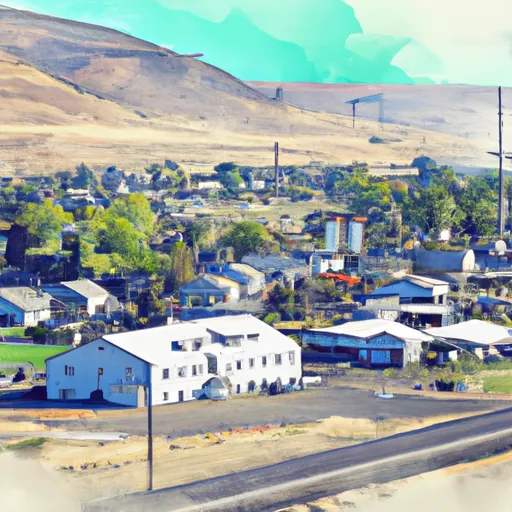-
 Snoflo Premium
Snoflo Premium
Get unlimited access to all our content
With no Ad interruptions! - Start Your Free Trial Login with existing account
Wishram
Eden Index
Climate
7.4
•
Recreation
7.3
•
Community
0.7
•
Safeguard
5.7/10

Wishram is a small town located in Klickitat County, Washington. Situated along the Columbia River Gorge, it offers a beautiful natural setting and a unique climate. Wishram experiences a semi-arid climate characterized by hot, dry summers and mild, wet winters. The average high temperature during summer months ranges from 80-90°F (27-32°C), while winter temperatures average around 40-50°F (4-10°C). Precipitation is relatively low, with an annual average of around 15 inches.
The hydrology constituents of Wishram are primarily influenced by the nearby Columbia River. The river provides opportunities for boating, fishing, and water-based recreation. The region is also known for its picturesque hiking trails, offering stunning views of the gorge and wildlife spotting opportunities. Outdoor enthusiasts can explore the nearby Columbia Hills State Park, which features trails winding through beautiful landscapes and showcasing petroglyphs left by Native American tribes.
In summary, Wishram, Washington, boasts a pleasant semi-arid climate with hot summers and mild winters. Its hydrology constituents are primarily shaped by the Columbia River, providing ample opportunities for water-based activities. Outdoor recreation enthusiasts can enjoy hiking trails and exploring the scenic beauty of the region.
What is the Eden Index?
The Snoflo Eden Index serves as a comprehensive rating system for regions, evaluating their desirability through a holistic assessment of climate health, outdoor recreation opportunities, and natural disaster risk, acknowledging the profound impact of these factors on livability and well-being.
Climate Health Indicator (CHI): 7.4
Wishram receives approximately
341mm of rain per year,
with humidity levels near 82%
and air temperatures averaging around
12°C.
Wishram has a plant hardyness factor of
7, meaning
plants and agriculture in this region tend to thrive during the non-winter months.
By considering the ideal temperature range, reliable water supplies, clean air, and stable seasonal rain or snowpacks, the Climate Health Indicator (CHI) underscores the significance of a healthy climate as the foundation for quality living.
A healthy climate is paramount for ensuring a high quality of life and livability in a region, fostering both physical well-being and environmental harmony. This can be characterized by ideal temperatures, reliable access to water supplies, clean air, and consistent seasonal rain or snowpacks.
Weather Forecast
Streamflow Conditions
Middle Columbia
Area Rivers
Middle Columbia
Snowpack Depths
Middle Columbia
Reservoir Storage Capacity
Middle Columbia
Groundwater Levels
Recreational Opportunity Index (ROI): 7.3
The Recreational Opportunity Index (ROI) recognizes the value of outdoor recreational options, such as parks, hiking trails, camping sites, and fishing spots, while acknowledging that climate plays a pivotal role in ensuring the comfort and consistency of these experiences.
Access to outdoor recreational opportunities, encompassing activities such as parks, hiking, camping, and fishing, is crucial for overall well-being, and the climate plays a pivotal role in enabling and enhancing these experiences, ensuring that individuals can engage in nature-based activities comfortably and consistently.
Camping Areas
| Campground | Campsites | Reservations | Toilets | Showers | Elevation |
|---|---|---|---|---|---|
| Avery Rec Area- Columbia River Gorge | None | 176 ft | |||
| Deschutes River State Rec Area | None | 191 ft | |||
| Giles French | None | 179 ft | |||
| Stimpson Flats - WDFW | None | 798 ft | |||
| Celilo | 20 | 177 ft | |||
| Beavertail | None | 559 ft | |||
| Maryhill State Park | 70 | 177 ft | |||
| Columbia Hills (Horsethief Lake) State Park | None | 166 ft | |||
| Leidl South - WDFW | None | 879 ft | |||
| Mineral Springs - WDFW | None | 502 ft |
Nearby Ski Areas
Catastrophe Safeguard Index (CSI):
The Catastrophe Safeguard Index (CSI) recognizes that natural disaster risk, encompassing floods, fires, hurricanes, and tornadoes, can drastically affect safety and the overall appeal of an area.
The level of natural disaster risk in a region significantly affects safety and the overall livability, with climate change amplifying these risks by potentially increasing the frequency and intensity of events like floods, fires, hurricanes, and tornadoes, thereby posing substantial challenges to community resilience and well-being.
Community Resilience Indicator (CRI): 0.7
The Community Resilience Indicator (CRI) recognizes that education, healthcare, and socioeconomics are crucial to the well-being of a region. The CRI acknowledges the profound impact of these elements on residents' overall quality of life. By evaluating educational resources, healthcare accessibility, and economic inclusivity, the index captures the essential aspects that contribute to a thriving community, fostering resident satisfaction, equity, and social cohesion.

